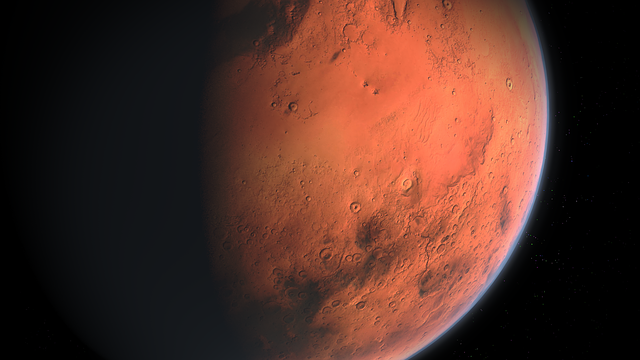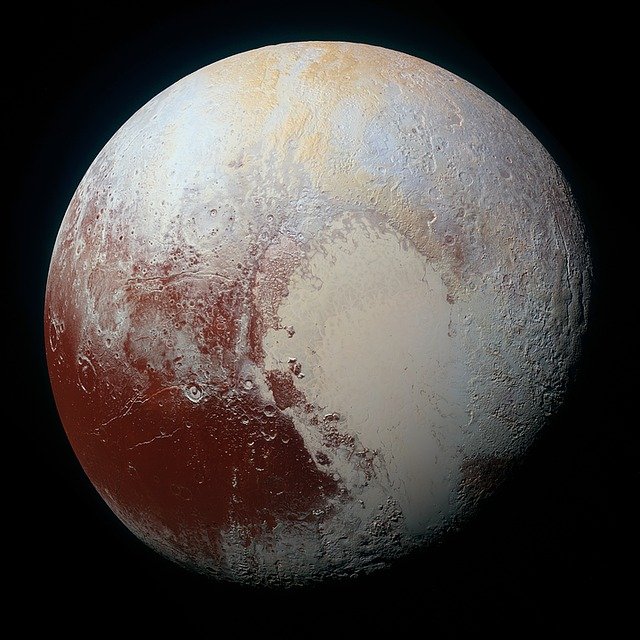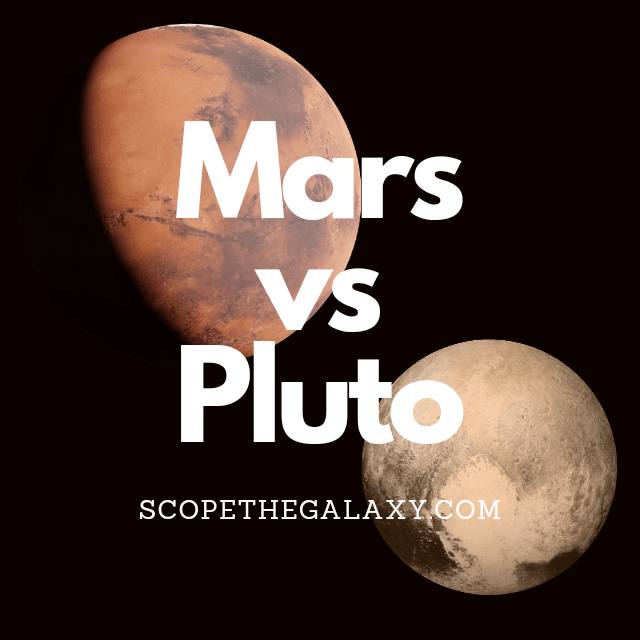*This post may contain affiliate links. This means we may make a commission if you purchase an item using one of our links*
The main differences between Mars and Pluto is that Pluto is a dwarf planet whilst Mars is a normal planet, Mars is the 4th farthest planet from the Sun whilst Pluto is 9th, Pluto is tidally locked to its moon Charon whilst Mars is not tidally locked to any of its moons, Mars is the warmer of the two planets, Mars has 2 moons compared to Pluto’s 5 and Pluto orbits the Sun elliptically whilst Mars does so in a circular pattern.
There are other differences between the two so continue reading if you want a more thorough breakdown of both planets, their similarities and their differences.
What Is The Planet Mars?
Table of Contents

Mars, also known as the red planet, is the celestial object that’s the front runner in our entire solar system to become a possible new home for us if terraformed. It is also the 4th farthest planet from the Sun and is one of 4 main line
terrestrial planets (not including Pluto) in our solar system.
This means that one year on Mars will take roughly 687 Earth days and a day on Mars is roughly the same as Earth at 24 hours and 37 minutes. It’s axial tilt is also very similar to that of Earth where it is positioned around 25 degrees to the right.
It may not be the largest terrestrial world in our solar system as its diameter is only 6,779km but, it does have the most moons amongst the normal terrestrial planet where two, namely Deimos and Phobos, are currently orbiting the red planet.
Like Earth and the other terrestrial worlds, Mars does have an atmosphere, certainly more visible than that on Mercury but, when compared to Earth’s it is merely 1% of its volume.
As a result it is more susceptible to larger debris striking its surface and is unable to trap in too much heat either. This is why it’s on the colder side with a temperature of around -65 degrees Celsius on average. On the contrary its core is significantly hotter at 1,350 degrees Celsius.
Mars is probably the most explored planet outside of our own, with a multitude of rovers like Sojourner (1997–1997), Opportunity (2004–2018), Spirit (2004–2010), Curiosity (2012–), and Perseverance (2021–) that have landed on the Martian soil to explore it.
Billionaires like Elon Musk and even Jeff Bezos are trying for an opportunity to genuinely have astronauts land on the Martian soil, possibly as early as 2029 so, Mars clearly has a lot interested in its terrain, as a potential substitute for Earth in the future.
What Is The Planet Pluto?

In the past Pluto was the 9th farthest official planet in our solar system however, in 2006 after many debates between astronomers, the International Astronomical Union officially downgraded it to a dwarf planet.
The reason for this downgrade at the time was primarily down to Pluto simply being very small when compared to every other planet and even the moons orbiting these planets. Pluto’s dwarf status is debated still to this day but, for now it still remains under this dwarf bracket for a planet
Its diameter for example is only 2,370km, which is a third of Earth’s Moon. With that being said, despite the significant size discrepancy Pluto shows, it still does have more moon like objects orbiting it than Earth and I’m not saying just one more.
In total this terrestrial dwarf planet has 5.
Pluto’s atmosphere consists mostly of molecular nitrogen whilst molecules of methane and carbon monoxide have been observed also. As for its surface, it consist mostly of frozen nitrogen, methane, and carbon monoxide ices.
One of Pluto’s most unique characteristic is that Charon (its largest moon) is tidally locked to it and vice versa, which means that the two essentially orbit each other.
In essence only one side of Charon and one side of Pluto surface will face each other at any given time.
Pluto’s temperature is between -222 to -232 degrees Celsius based on how close it gets to the Sun when orbiting it, whilst its core temperature isn’t anything too special sitting around 500 – 1,000 degrees Celsius.
The main reason it’s as cold as it is and has a relatively cold core in comparison to the other planets would be, which is mostly down to its size. A larger size would mean more mass could be compressed at the center which would produce more heat at the core.
Pluto’s orbit is also different from the other main plants in our solar system, following an elliptical orbital path as opposed to the circular path the others take. As a result of its distance from the Sun, Pluto will complete each one of these elliptical cycles around once every 247.78 years.
Even its rotational cycle is very slow, where one cycle is completed in 157 hours. Another interesting fact is the Pluto’s axial tilt is almost on its side at 57 degrees, similar to Uranus.
Similarities Between Mars And Pluto
Both Mars and Pluto do have a few similarities , which in this case includes the following:
- Both have a hotter central core.
- Both have multiple moons.
- Both are terrestrial planets.
- Both have an atmosphere and a rocky surface.
- Both have a spherical shape.
- Neither are tidally locked to the Sun.
- Both have no rings surrounding them.
Differences Between Mars And Pluto
As for the differences, they include the below:
- Mars is the 4th farthest planet from the Sun whilst Pluto is the 9th farthest planet. As a result it takes Mars 687 days to complete an orbit around the Sun whilst Pluto takes 247.78 years to complete its orbit.
- Pluto follows an elliptical orbit around the Sun whilst Mars follows a circular orbital pattern.
- Mars is the hotter of the two planets although it is very cold still at -67 degrees Celsius compared to between -222 to -232 degrees Celsius on Pluto.
- It take Mars 24 hours and 37 minutes to complete a day whilst Pluto does so in 157 hours.
- Pluto has an axial tilt of 57 degrees which is far more than the 25 degrees of Mars.
- Pluto has 5 moons as opposed to the 2 Mars has.
- Pluto is tidally locked to its moon Charon whilst Mars is not tidally locked to any of its moons.
- Mars is the bigger of the two with a diameter of 6,779km compared to Pluto’s diameter of 2,370km.
- Mars is red in color whilst Pluto is a mixture of off-white, light blue and has patches of deep red.
- Pluto is not as heavy with a mass of 1.30900 × 10^22 as opposed to Mars’ mass of 6.39 × 10^23 kg
- Mars has a stronger magnetic and gravitational field, mostly as a result of its size.
- Mars has an observed 120 craters (with 43k said to potentially be on its surface) whilst Pluto has roughly 1,000 craters on its surface.
- Pluto is less dense where it is 1.88 g/cm³ whilst Mars has a density of 3.93 g/cm³
Summary
Although some aspects of Mars are the same if not very similar to Pluto such as their terrestrial composition, the fact both orbit the Sun and their multiple moons, they still differ in more ways.
Whether it be their differences in size, temperature, orbital cycle around the Sun, their gravitational strength, magnetic field strength and beyond. So, despite the common features, Mars and Pluto are very different from one another and that can be more clearly outlined when the differences are broken down.


